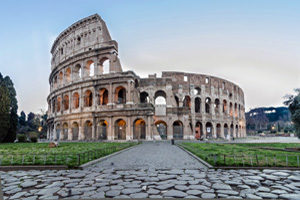Tourist itineraries – Discovering… Ancient Rome!
 The “Ancient Rome” itinerary is the ideal touristic route for enthusiasts of ancient Roman history and art in ancient Rome.
The “Ancient Rome” itinerary is the ideal touristic route for enthusiasts of ancient Roman history and art in ancient Rome.
We suggest you to start discovering Colosseum, the undisputed symbol of the city, and Constantine’s Arch, erected in 315 AD. to remember Constantine’s victory over Massenzio. Nearby you can find Circus Maximus and the beautiful Via dei Fori Imperiali, a great testimony to the architecture and social life of ancient Rome…
Right at the forums, in particular at the Forum of Augustus and at the Forum of Caesar, is dedicated to the reconstruction curated by Piero Angela “Travels in the Old Rome”, an event held from April to November which has been successful in past editions: in a creative way you can visit and relive the stones and the remains of the Forum, with a faithful reconstruction of the places and special effects of every kind.
Not to miss Basilica of Massenzio and Tito’s Arch, in the same area, Forum of Trajan, the largest Roman Forum, designed in 107 AD. by the famous architect Apollodoro of Damascus, and Trajan Column, erected in honor of the emperor, to contain his ashes and to remind his businesses against the Dacians.
And even Mamertino Prison, where St. Peter was traditionally sanctified, Basilica SS. Cosma and Damiano, with the magnificent apsidal mosaic, and church of Santa Francesca Romana that preserves the beautiful icon of the Madonna of the middle of the fifth century, to end with a visit to Domus Aurea, overlooking the view over the Circus Maximus with Palatine Hill to admire the most beautiful Roman villas (the house of Livia, the house of Augustus).
A few hundred meters away are Caracalla’s Baths, still preserved for much of their structure, the most sumptuous in the capital of the Roman Empire, although destined for the mass use of the people of the neighboring popular districts of the 12th Regio, while the classes the more abundant social ones used to frequent the spas of Agrippa, those of Nerone or, above all, the thermal baths of Traiano at the Esquiline hill. Subsequently, they were exceeded only by Diocletian’s baths, but the ruins of Caracalla’s baths are the most intact example of the great imperial baths.
If you have a bit of time, we recommend a visit to the archaeological sites of Via Appia “Regina Viarum”: from S. Sebastiano’s Gate, you can come before the Church of Domine quo vadis? on the place where, according to tradition, a meeting between the Apostle Peter and Christ himself would take place, then cross the Sanctuary Catacombs area and reach the Basilica of San Sebastian. Here you can visit one of the most impressive catacombs in Rome still accessible to the public.
Crossing the area of the Villa of Massenzio, you can reach one of the most famous monuments in Rome and symbol of Via Appia Antica: the Tomb of Cecilia Metella, daughter of Metello and wife of Crasso, son of that Marco Licinio Crasso who in the 60’s. had formed the first triumvirate with Caesar and Pompey.
Not far away there is one of the largest suburban villas in Rome, Villa dei Quintili, originally owned by the noble Quintiles brothers, accused of conspiracy and consequently condemned to death by Commodor Emperor. Their property was confiscated and entered into possession of the emperor himself, becoming part of the imperial deman.
In the villa there is still the huge spa complex, which remains part of the marble decorations.

 Re di Roma Area
Re di Roma Area Find out…
Find out… Visiting…
Visiting… Moving in Rome
Moving in Rome Concerts
Concerts Exhibitions
Exhibitions Sport events
Sport events